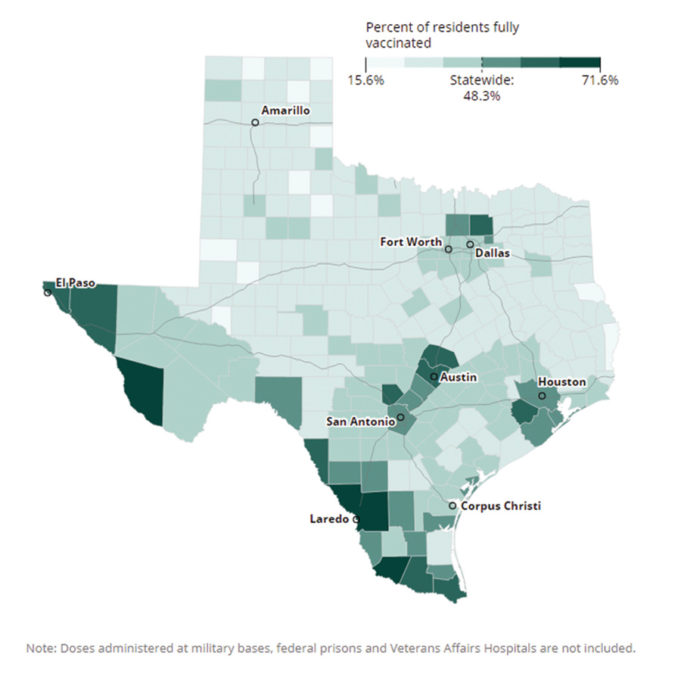Vaccine doses reported
INCREASED by 21,161 doses compared with the 30-day average a month ago. An average 82,390 vaccine doses were reported each day in the last month and 48.2% of Texans are fully vaccinated.
Hospitalizations
DECREASED by 223 patients compared with a week ago.
As of Sept. 5, 13,545 Texans are hospitalized for the coronavirus.
Average new cases
INCREASED by 2,538 cases compared with the seven-day average a week ago. On Sept. 6, 2,607 new confirmed cases and 1,221 new probable cases were reported.
Average new deaths
INCREASED by 47 deaths compared with the seven-day average a week ago. On Sept. 6, 53 new deaths were reported.
What you should know
The highly transmissible delta variant of the coronavirus is spreading rampantly in Texas. Gov. Greg Abbott is resisting statewide restrictions on businesses and has fought to ban local leaders from implementing mask and vaccine mandates.
Hospitals: After a rapid surge over the summer, COVID-19 hospitalizations have leveled off just below the pandemic’s winter peak. Still, people under 50 make up a larger share of hospital admissions, and more Texas hospitals are reporting ICU bed shortages than at any other point of the pandemic. Hospitals are struggling with historically low staffing levels, and the state is sending thousands of contract health care workers in to help. Stressed health workers are also confronting volatile visitors and patients.
Ban on mask mandates: Cities, counties, and school districts in the state’s major urban areas have filed a flood of lawsuits challenging Abbott’s executive order. On Friday, the governor argued in court that he can’t enforce his mask mandate ban — it’s up to local prosecutors.
Impact on schools: Texas lawmakers have approved a bill to fund virtual learning, but it would exclude students who failed their STAAR exams. More Texas students tested positive for COVID-19 between Aug. 16 and Aug. 22 than at any time last school year. At least 45 districts have shut down in-person classes due to COVID-19 cases, affecting more than 40,000 students.
How many Texans have been vaccinated?
As of Sept. 5, 16.7 million people have received at least one dose, which is 57.5% of Texas’ population, and 14 million people, or 48.2%, are fully vaccinated. A total of 29.5 million doses have been administered. The Pfizer and Moderna vaccines require two doses, and the Johnson & Johnson vaccine requires one dose.
Texas received its first shipments of the COVID-19 vaccine on Dec. 14. The vaccines are available to everyone age 12 and older in Texas, regardless of occupation or health status.
Health experts emphasize vaccinating as many people as possible to curb the virus’ spread, and 83% of Texans are age 12 and older and thus eligible for a vaccine. The Centers for Disease Control and Prevention (CDC) recommends people previously infected get vaccinated because scientists aren’t sure how long immunity lasts for them and vaccination further boosts protection against COVID-19.
The state’s vaccination effort has faced geographic and demographic challenges, including a higher-than-average number of people who are too young to get the vaccine and around 11% of the population living in rural counties, where health care is harder to access.
In whiter, more rural areas, where the fully vaccinated rate has consistently lagged the statewide rate, vaccine hesitancy is often connected to mistrust in the government. For Hispanic and Black Texans, it commonly stems from a mistrust in the health care system.
State health officials initially rolled out vaccine hubs to help administer shots, but in May, the state shifted the responsibility to doctors, pharmacies, public health offices, and other, smaller providers who have closer relationships with the community.
Who is getting vaccinated?
The first groups eligible for vaccines were long-term care facility residents and staff, Texans age 65 and older, front-line health care workers and people age 16 and older with qualifying health conditions. The virus has mostly killed people 60 years and older, prompting urgency in efforts to vaccinate older Texans.
The distribution of the vaccine is unequal, according to a Texas Tribune analysis. Among people who have received at least one shot, the percent of white recipients is in line with their proportion of the state’s population, while Hispanic and Black residents are being vaccinated at lower rates. In Texas’ most populous counties — Harris, Dallas, Tarrant, Bexar, and Travis — neighborhoods with the highest proportions of Hispanic and Black residents are some of the least vaccinated areas.
Advocates say that language barriers and lack of access to health care providers and transportation have contributed to these trends. Lower income individuals face challenges trying to book a vaccine appointment through a process that favors people who have easy access to the internet and transportation.
The Hispanic and Black populations in Texas are younger compared with the state’s white residents, which adds to the disparities. Around 20% of the Hispanic population is under 12, and none of the vaccines are approved for children below 12. A majority of Texans age 80 and older are white.
Where are most of the COVID-19 cases in Texas?
As of Sept. 6, the state has reported around 3.7 million cases, with 3.1 million confirmed cases reported in 254 counties and 589,701 probable cases reported in 230 counties since the pandemic began. Confirmed cases are detected by molecular tests, such as PCR tests, which are taken with a nasal swab and are highly accurate, according to the U.S. Food and Drug Administration. Probable cases are detected through rapid-result antigen tests, which are faster and less accurate.
These totals may differ from what county and city health departments report. The Tribune is measuring both the number of cases in each county and the rate of cases per 1,000 residents in the last two weeks.
How many people have died?
The first death linked to the coronavirus in Texas occurred March 15, 2020, in Matagorda County. As of Sept. 6, 57,110 people who tested positive for the virus have died in Texas. The Texas Department of Health and Human Services (DSHS) counts deaths based on death certificates that list COVID-19 as the cause of death, which excludes deaths of people with COVID-19 who died of another cause.
Some regions with the highest mortality rates are predominantly Hispanic. The virus has been more deadly in Hidalgo and Cameron counties in the Rio Grande Valley, where death rates rival more populous parts of the state like Dallas and San Antonio. In El Paso County, thousands of residents have died of COVID-19 since the pandemic began, placing the region far ahead of other major urban counties in deaths per 1,000 residents.
How many new cases are reported each day?
The state reports the number of new confirmed cases and probable cases of the coronavirus in Texas each day, which excludes backlogged cases. The number of new cases reported drops on weekends, when labs are less likely to report new data to the state.
New variants of the coronavirus that seem to spread more easily have been found in Texas, though preliminary studies suggest that vaccinations are still effective against the variants.
The state reports very limited demographic data for people who have had COVID-19, so the impact on Texans of color is difficult to measure.
There are 589,701 known probable cases in 230 counties, including 1,221 newly reported cases on Sept. 6. The state began reporting probable cases, which can be detected through antigen tests, in November. A total of 24 counties, including Harris, Travis, and El Paso, are not reporting probable cases to the state, though antigen tests may take place there.
How many coronavirus tests are coming back positive?
The positivity rate measures how prevalent the virus is in Texas. A rate over 10% puts states in the “red zone,” according to federal guidance. During Texas’ two largest outbreaks, the rate exceeded 20%, meaning one in five tests were positive.
This rate is calculated by dividing the average number of confirmed cases by the average number of molecular tests conducted over the last seven days. This shows how the situation has changed over time by deemphasizing daily swings.
DSHS reports a second positivity rate based only on rapid-result antigen tests, which detect probable cases. As of Sept. 3, the rate was 8.6% out of 6.5 million tests.
How many tests have been administered?
As of Sept. 5, Texas has administered 38.6 million tests for the coronavirus since March 2020. We do not know the number of Texans who have gotten a test because some people are tested more than once. The state’s tally does not include pending tests.
The Texas Tribune is using daily data from DSHS to track coronavirus vaccinations, cases, hospitalizations, and deaths. The state data comes from vaccine providers, city and county health departments, hospitals, and laboratories. It may not represent all cases of the disease given limited testing.
A version of this story originally appeared in the Texas Tribune.












